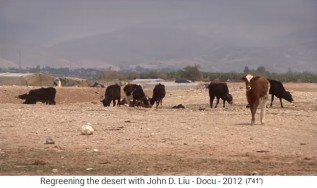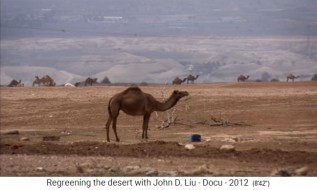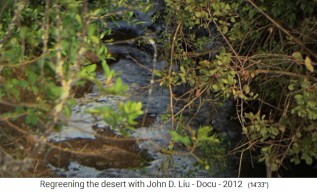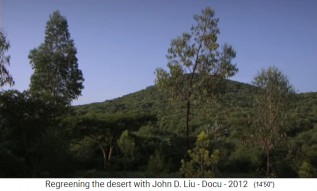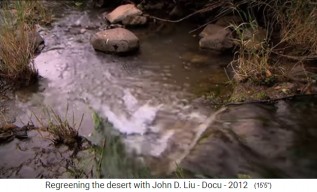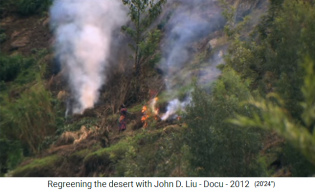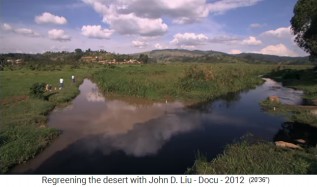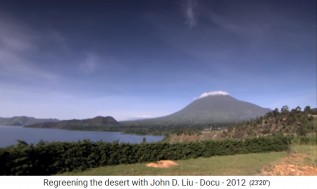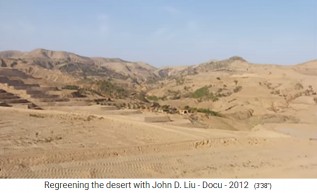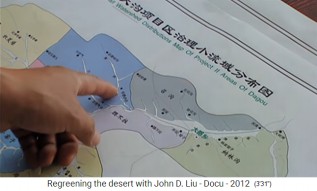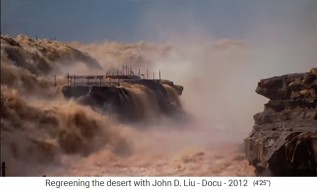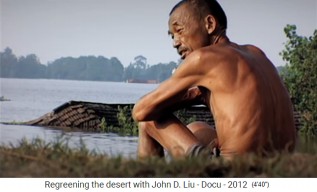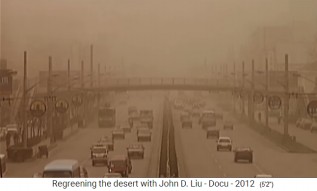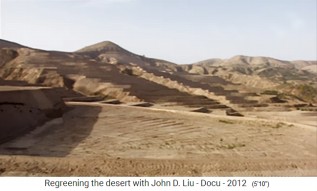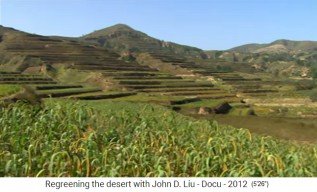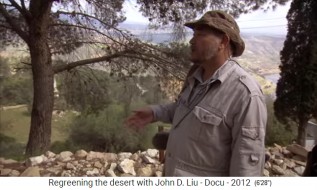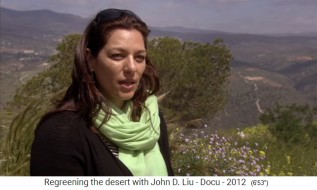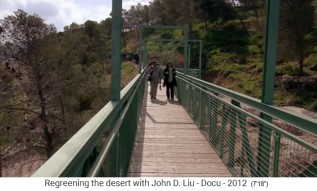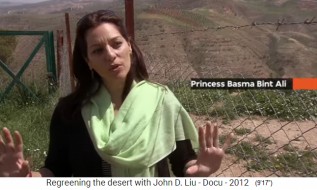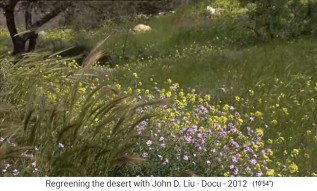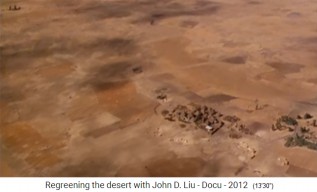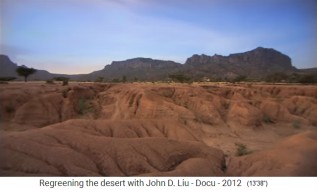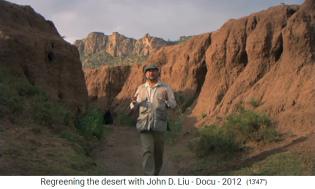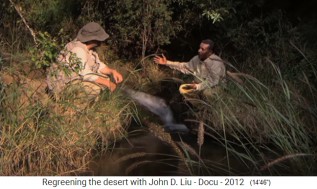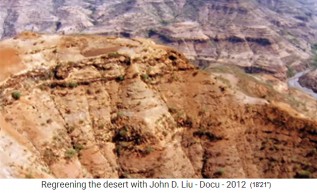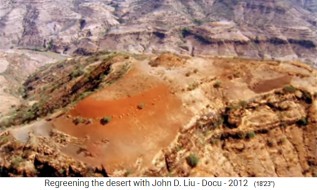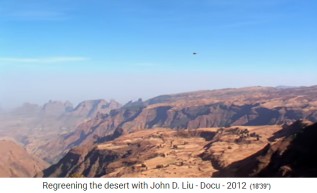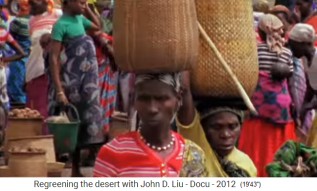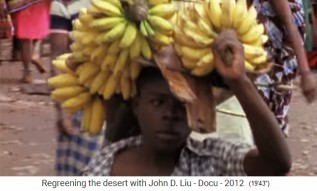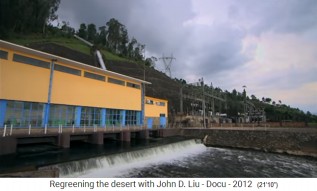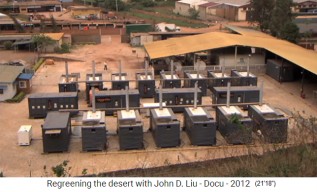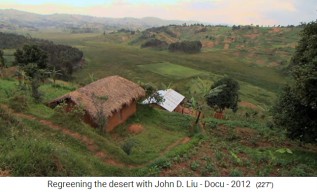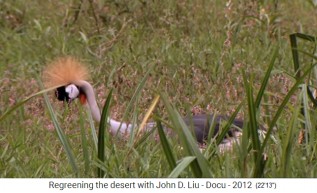John D. Liu also made an own film
about China: "Hope
in a changing climate"
========
John D. Liu, cameraman and ecologist
John D. Liu, ecologist and cameraman, has a clear
statement: You can revive broken ecosystems that are
just deserts, and this can happen all over the world
(1'7'').

John D. Liu, portrait
1) China, the bare Loess Plateau (Huangtu
Plateau) and the consequences with floods and
sandstorms (smog) in large cities
John D. Liu has made his own film about the regeneration
of the Loess Plateau: "Hope in a changing climate"
(2'41'').
Cameraman John D. Liu began his presentations on
ecosystem regeneration in 1995 when he was commissioned
to report about the restoration of the ecosystem on the
Loess Plateau in China (1'34''), an area that big like
Holland (1'44''). The desert was transformed into an
oasis, and presenting this principle became the life
goal of John D. Liu (1'54'').
China Loess Plateau, fertile
terraces - Film title: Regreening the Desert
Liu saw that all over the world there were such desert
regions where people had not understood how the
ecosystem worked, so that it was dried up (2'31''). Liu
made his own film about the regeneration of the Loess
Plateau "Hope in a changing climate" (2'41''), which is
also on the internet (2'46'').
The Loess Plateau in China,
satellite photo - China Loess Plateau, the desert
landscape until 2000 1,2
The Chinese landscape architects of the regeneration
project noticed during their investigations that
agricultural overuse was the cause of the devastation
(3'35''). Herds of cattle were constantly led over the
mountains, which were bare-eating the mountains. They
left young shrubs and trees no chance to grow (3'45'').
The rain in the region filled the waters unhindered,
eroded the loess soil and caused flooding in the
lowlands (4'42'').
China Loess Plateau, the regeneration project for the
Dagou region, Map - a herd of goats eats a mountain
bare - China: The Yellow River steals the loess from
the Loess Plateau
The river regularly formed loess mats on which one could
walk, a tourist attraction (4'50''). In the dry season,
sandstorms caused loess dust to provoke dense smog in
Chinese cities (5'2''). These loess dust clouds even
reached neighbouring countries (5'6'').
On the Loess Plateau it was proven for the first time
that devastated ecosystems can be regenerated, and this
can be done worldwide (5'42''). John D. Liu became an
ambassador for the environment of many governments and
presented his knowledge and experience (5'53'').
China: Loess Plateau with desert
and devastated terraces - China: The regenerated Loess
Plateau with planted terraces
2) Jordan: 1000s of years overgrazed - fenced areas
regenerate in 3 years - extinct plants grow again
Example Jordan: The desert spreads more and more, and
water becomes scarcer and scarcer (5'59''). Liu was
invited to Jordan by the royal family. Princess Basma
Bint Ali wants to stop the desertification (6'11'').
Princess Bent Ali shows Liu the botanical garden, so
that Liu can inform himself about the plant world of
Jordan, with which plants the country of Jordan could
become green again at the end (6'36'').
Jordan, Princess Basma Bint Ali in the Botanic Garden
02 - Jordan, Princess Basma Bint Ali and John D. Liu
in the botanical garden crossing a pedestrian bridge -
Jordan, meager grass soils and some forest
Herd of cows and herds of sheep are always eating
everything and only desert soil remains (7'54''). Liu:
"Well, this was the land of 'milk and honey'. This was
the promised land (7'54''). These are the places were
historically people have done agriculture and animal
husbandry for 1000s of years (8'6''). But the lands are
exhausted. they allow 100s of 1000s of sheep and goats
to walk across here, and any green thing that sticks up
it's head is food. And they are just walking around here
getting everything (8'26''). Well, you can't let them do
that anymore, they'll have to stop, they've been doing
that since thousands of years, and that's what has
destroyed this area. So when that doesn't stop, you
won't be able to fix this." (8'39'')
Princess Basma Bint Ali: "The way we've done is: we
excluded grazing for the first three years (9'4''), and
that worked out very well, and in that three years, this
is when we discovered the species that came up on its
own which were thought to be extinct (9'10''), and was
last recorded in the 1800s, it just ame up on its own,
so we allowed the land to breathe, to take a breath, and
to see what's going on (9'20''), we didn't interfere, we
didn't do any planting at the time, just to see how it
react (9'24''), and that gave us a lot of feedback of
how we can deal with or how to rehabilitate areas
(9'31''), so was very efficient for us, and as you can
see here, [pointing to the not protected area], it's
very overgrazed, it's very barren, this is outside our
border, and then within here, you can see the
difference." (9'44'')
Liu: "Just by making a fence around this place, you'll
get back grasses (9'55''). That's what's so
extraordinary (9'57''). Now when you get back grasses,
that means each year: first of all you have perennial
root systems [roots of plants lasting several years],
and they will all spread out (10'3''), and you will have
microbial communities living and growing in this
microclimate that is created (10'12''), so then you
won't have direct sunlight hitting (10'15''). You won't
have UV radiation irradiating and sterilizing this
microbial object habitat (10'20''). So, everything will
change. Then you are in a cumulative situation, now you
are in a disaccumulative situation (10'28'') where
there's always less vegetation, always less organic
matter, always less biodiversity (10'35''). That's
exactly wrong, we need to shift that to always more
organic matter, always more biomass, always more
biodiversity." (10'45'')


Jordan, bare soil by overgrazing - Jordan, regenerated
landscape fenced in for 3 years
"I cannot stand and watch our land be degraded and
ignorant people abusing it (10'55''), it's my duty to
take a stand to make things better (10'58'') and I've
carved out my world in the environment, other members of
the [Royal] family [of Jordania] have taken on various
different topics, but this is my little niche (11'8'').
Liu: "So now, it's
been really a long time since I began, and so, I'm
far down the path - ehm, and I think if you go down
this path, and you start to look and you say: well,
that's an interesting phenomenon, you can see the
relationship between hydrology and vegetation and
biological life (11'44''), and you realize it: Well,
actually that's the basis of the air, and the
natural water system, and it's how it was how the
atmosphere and the hydrological cycle were created
(12'1''). And how they were constantly renewed, and
then, you come to places like this, which are
massively degraded, and you realize that people
aren't thinking about this ecological fuction
(12'19''). They're ignoring the science that we know
about this, and they are believing that what's
important is to produce something (12'29''), but
actually, that's not the most important thing right
now. The most important thing for survival and
sustainability for Humanity is that places - not
just individual places, but the entire planet - is
funcitonal (12'46''). If we understand how the
natural evolutionary processes work, and we emulate
those and we don't disturb those by our behaviors,
we can live in the Garden of Eden." (12'58'')
3) Ethiopia (Africa): New springs in the high plains
by forested mountains
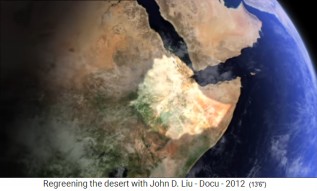
Äthiopien, satellite photo
In the Ethiopian plateau, agriculture has destroyed the
soil, leaving only desert (13'36''). In the rainy season
the rainwater provokes erosion and whole gorges because
the water cannot seep into the hard soil (13'57'').
During the dry season everything is dried out and hunger
is the consequence (14'4''). In only 6 years, the
Ethiopian plateau could regenerate by planting local
trees and plants (14'26''), and springs and waters
returned (14'33''). Rainwater on the wooded mountain
slopes is seeping into the ground and is coming out in
form of creeks (15'1'').
The plateau of Ethiopia, a desert
until 2005 - and much erosion until 2005 - the erosion
in the plateau has created deep gorges.
Within 6 years, the landscape has regenerated with the
planting measures, including waters (15'24''). A few km
north in the village of Abraha Atsebaha, where the
landscape has also been regenerated, the old wells have
filled up, although it has hardly rained this year
(15'44''). In 1984 the valley went through a severe
famine (15'49''). The emigrated people now come back
(15'57''). The village was renaturalized with state help
and everything is green again. Small dams are built in
the fields (16'44''). At the dams the water is dammed
up, small ponds are formed, so that the water is slowly
seeping into the ground feding [the ground water and]
the water springs (16'57''). The farmers were able to
set up new farming activities with little fields,
accompanied by fruit trees including papaya, sunflowers
and beehives (17'28''). The wells are again filled with
water (17'38''). Fields with an inclination were
terraced (17'46''), and fields with a slight inclination
were given earth dams with water holes in front of them
so that the rainwater would seep down well and not run
off (17'52'').
Ethiopia: A wooded mountain
provokes a flowing stream - the stream - Ethiopia, the
regenerated plateau with the village of Abraha
Atsebaha
The list of measures in the village of Abraha Atsebaha,
highlands of Ethiopia:
Step 1: In the high mountains many ponds are installed
so that the rainwater is dammed up and is slowly seeping
down into the ground, therefore the creeks come out
again [and ground water levels are rising] thus the
wells are fillied with water again (16'57'').
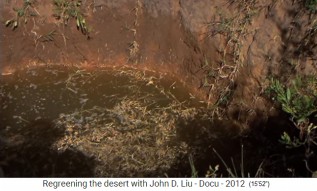

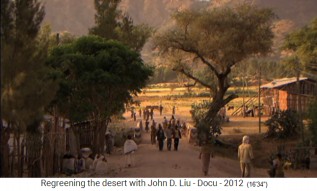
Ethiopia, village of Abraha Atsebaha, wells are
filling again - Ethiopia, village of Abraha Atsebaha,
livestock in the desert - Ethiopia, the regenerated
village of Abraha Atsebaha, a village road



Ethiopia, the regenerated village of Abraha Atsebaha
with a park - with bushes and trees on hills - a pond
in the highlands

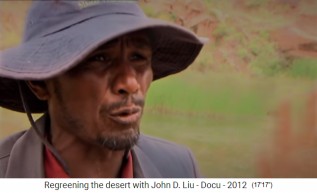
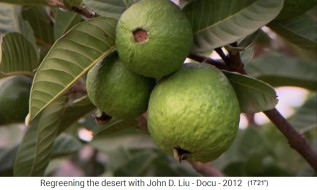
Ethiopia, the regenerated village of Abraha Atsebaha
with ponds in the highlands 02 - Ethiopia, the village
leader of Abraha Atsebaha - Ethiopia, the village of
Abraha Atsebaha recently has fresh fruits, these are
guavas

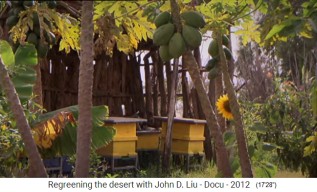

Ethiopia, the village of Abraha
Atsebaha with papayas and trees - with papayas,
sunflowers and beehives - with a drawing fountain with
crank
Step 2: Fields with inclination are terraced so that
rainwater is seeping down and does not run off (17'46'')
Step 3: Fields with a slight slope are subdivided by
earth dams with water holes on the mountain side so that
the rainwater on the fields seeps down better into the
earth and does not run off (17'52'').
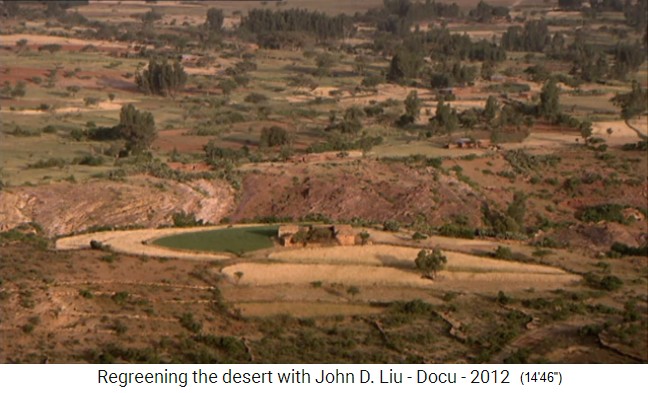

Ethiopia, the village of Abraha Atsebaha, slopes are
terraced - Ethiopia, the village of Abraha Atsebaha,
fields with little inclination receive earth dams and
water holes so that the water seeps down into the
earth at the place and does not run off
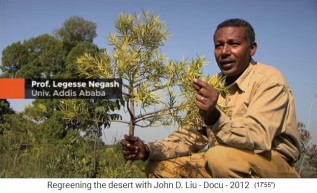
Ethiopia, Prof. Legesse Negash from the University of
Addis Ababa
Prof. Legesse Negash from the University of Addis Ababa
says: "Africa must renature its devastated regions, that
is the task no. 1 for Africa (18'16''). There is
Egypt, there is Sudan, where the Nile flows through. So
if Ethiopia, where the Nile originates, renatures its
landscapes, then this is also a work for Egypt and
Sudan. So the renaturation of the landscapes is not only
a national, but even an international affair (18'38'').
4) Jordan: John D. Liu in the guest
house
Cameraman John D. Liu was invited to Jordan by the staff
of the royal princess to transform the desert into a
fertile green landscape (19'25'').
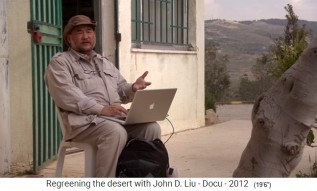
John D. Liu in Jordan
John D. Liu on his work as an ecologist: As an ecologist
the work is combining many documents and data,
hydrology, soil, organic material, moisture, governments
need strategic plans that are understandable for
everyone in the government when they want to rearrange
the landscape. (19'25'')
Quote:
"Well, it's with videos, but there are also
a lot of documents, there are studies on hydroligy,
and studies about the relationship between soil and
organic matter and moisture (19'9''). You know, the
type of strategy documents that governments need to
see, what they are going to do (19'20''), so they have
to have a strategy that everyone can see (19'25'').
5) Rwanda (Africa): deforestation and field farming
on slopes provoked erosion - farmers moved to the
Rugezi Wetlands nature reserve draining the soil and
reducing the flow of the river

Map of Rwanda with the Rugezi Wetlands and Kigali
Rwanda is another success story (19'33''), where John D.
Liu has advised the government of Paul Kagame (19'38'').
Market in Rwanda 1,2 - Rwanda,
President Paul Kagame
The renaturation of the desert areas in Rwanda worked
perfectly (19'45''). Paul Kagame, President of Rwanda,
means: We had to find out what had happened and how it
was related to the actions of the people (20'1''), how
people can destroy the landscape, or rebuild and protect
it (20'14''). - There was too much farming on mountain
slopes, so that erosion washed away the earth. The
peasants then moved to the
Rugazi
Wetlands, an internationally important wetland,
where the soil was drained and the wetland was destroyed
(20'48'').
Quote:
"We had to take careful look at what had
actually been happening that damaged this system
(19'54''), and therefore harder to reverse that again
with the human action (20'0''). And this way it is
important to look at how human actions can destroy or
can reverse what has been destroyed, or even protect
our environment." (20'13'')
Rwanda, the Rugezi Wetlands 01 -
River in Rwanda - Rwanda, power station on the river
In addition, the way from the Rugezi Wetlands to the
capital city of Kigali was 3 hours drive (20'54'').
Drainage of the wetlands reduced the runoff, power
stations [on the
Nyabarongo
River?] produced less power, and the government
had to install additional diesel machinery for
electricity (21'20''). Therefore just all had to be
renewed: the mountain landscape and the wetlands
(21'30'').
Diesel Generators in Rwanda - the
Rugezi Wetlands 2,3
The peasants were induced to move away from the wetlands
returning to their ancestral lands. The mountain slopes
had to be systematically terraced and planted with trees
and shrubs to stop the rainwater and secure the earth
(21'47''). And the wetlands are also coming back
(21'53''). The river power plants are back in full swing
and the diesel generators are no longer needed (22'1'').
The electricity price was stabilized (22'5''). And in
the wetlands, biodiversity spreads back as in former
times (22'16'').
Rwanda, biodiversity comes back
with flowers and butterflies - Rwanda, a cornfield or
millet field in the valley
6) Make ravaged soil fertile - secure global food
production
Liu: If humanity is always going to increase by one
billion in 12 years, we need to distance ourselves from
consumerism and develop a sustainable life (22'39'').
With this model, watercourses are restored, fertility is
restored (22'52''), and there are vast areas of land
left to regenerate (22'54''), new agriculture can be
created, and millions will have new work (23'9'').
Millions of people can have additional work and the
lives of future generations will be secure (23'10'').
Trees stabilize the mountains and are leading the water
flow deep into the ground (24'0''). And every tree
releases new oxygen with photosynthesis (24'12'').

Ethiopia, Prof. Legesse Negash from the University of
Addis Ababa
Prof. Legesse Negash, University of Addis Ababa: In
addition, every tree is a protection against climate
change (24'33''). Trees are holding back the rain and
are leading the water deep into the ground into the
groundwater system (24'56''). When this water is lost,
the biological system gradually dies (25'11''). So that
is going on since millennia and at the end comes the
collapse (25'17'').




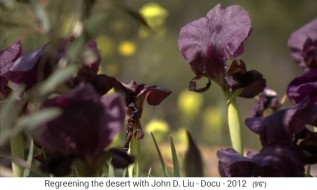

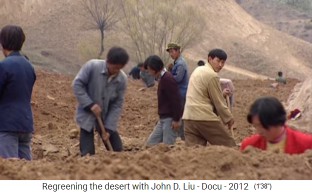



China Loess Plateau, John D. Liu in the desert of the Loess Plateau - with sun hole - John D. Liu already made a film "Hope in a changing climate" before.


